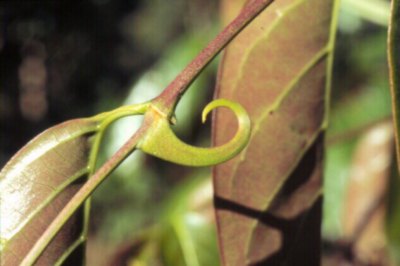Cat’s Claw
[size=75]From Wikipedia, the free encyclopedia [/size]
Cinchonoideae
Uncaria tomentosa (popularly known in English as Cat’s Claw, in Spanish as Uña de Gato or as indian name Vilcacora) is a woody vine found in the tropical jungles of South and Central America, which derrives its name from its claw-shaped thorns. It is used as an alternative medicine in the treatment of a variety of ailments.
Uncaria tomentosa is a liana deriving its name from hook-like thorns that resemble the claws of a cat. U. tomentosa can grow up to 30m tall, climbing by means of these thorns. The leaves are elliptic with a smooth edge, and grow in opposite whorls of two. Cat’s claw is indigenous to the Amazon rainforest, with its habitat being restricted primarily to the tropical areas of South and Central America. There are two species of Cat’s Claw, Uncaria tomentosa and Uncaria guianensis, each having different properites and uses. The two are frequently confused but U. tomentosa is the more heavily researched for medicinal use[1] and immune modulation, while U. guianensis may be more useful for osteoarthritis.[2] U. tomentosa is further divided into two chemotypes with different properties and active compounds, a fact ignored by most manufacturers[3] that can have significant implications on both its use as an alternative medicine and in clinical trials to prove or disprove its efficacy.[4]
The parts used medicinally include the inner bark and root, taken in the form of capsules, tea and extract.
U. tomentosa is used in nootropic drugs, as well as in treatment of cancer and HIV infection. It contains several alkaloids that are responsible for its overall medical effects, as well as tannins and various phytochemicals.[5] The chemotype of the plant determines the dominant type of alkaloid it produces, and thus its properties in vivo. One chemotype has roots which produce mostly the pentacyclic alkaloids that are responsible for the immune-strengthening effects desired by most consumers. The second chemotype produces tetracyclic oxindole alkaloids known as rhynchophylline and isorhynchophylline which counteract the immune-strengthening actions of the pentacyclic alkaloids, reduces the speed and force of the heart’s contraction, and in high doses produce ataxia, lack of coordination and sedative effects.[4] Since U. tomentosa comes in at least these two different chemotypes, without chemical testing it is impossible to know which chemical compounds will predominate in a plant collected randomly from a natural setting.
Some ingredients appear to act as anti-inflammatory, antioxidant and anticancer agents.[5] As a homeopathic treatment, Cat’s Claw is used to treat intestinal ailments such as Crohn’s disease, gastric ulcers and tumors, parasites, colitis, gastritis, diverticulitis and leaky bowel syndrome, while manufacturers claim that U. tomentosa can also be used in the treatment of AIDS in combination with AZT, the treatment and prevention of arthritis and rheumatism, diabetes, PMS, chronic fatigue syndrome, prostate conditions,[6] immune modulation,[7] Lyme disease[8] and systemic lupus erythematosus.[9] A 2005 review of the scholarly literature on Cat’s Claw indicates there is supporting evidence toward its use in treating cancer, inflammation, viral infection and vascular conditions, and for its use as an immunostimulant, antioxidant, antibacterial and CNS-related agent.[5]
